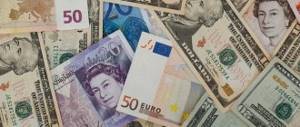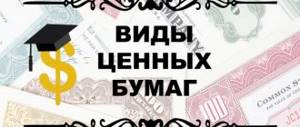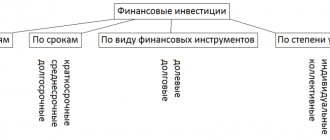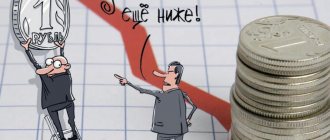The pages of the website tradernew.pro talk a lot about how to trade in financial markets and what needs to be done in order for this trading to be profitable. Most often we are talking about currency trading. But in order to understand this topic in detail, you need to master the fundamental concepts. What is a currency, what types of currencies are there, and what is it used for in the Forex market?
Types of international currencies
Conventionally, we can distinguish the types of international currencies that are used in a number of countries as the main payment unit. The American dollar and euro can easily be included in this category.
Despite the fact that these monetary units are gradually losing their stability, their exchange rate increasingly depends on the foreign economic situation in the world; the main calculations are carried out in dollars and euros. Prices for large goods in our country are also, one way or another, tied to the dollar. If you are going to buy real estate or transport in the foreseeable future, it is better to collect money for these purposes in foreign currency.
What are the different forms of international payments?
1) Advance payment.
This option is the safest for the exporter, but in a competitive market, few people will agree to it. A partial advance payment (eg 20-30%) may be more acceptable to the importer and therefore more realistic, but still ultimately exposes the exporter to risk. Despite the high risks for the importer associated with paying an advance in cash, some importers conclude that they have no other choice. Importers from developing countries often consider advance payments necessary to obtain high-demand or luxury goods. Advance payments may be made against the presentation of a bank guarantee issued by the exporter's bank.
2) Deferred payment, supported by a standby letter of credit or bank guarantee.
This option is sometimes neglected by exporters who have a strong position. The exporter provides the opportunity to pay on an open account basis with security in the form of a standby letter of credit or bank guarantee. If the importer does not make payment within the time specified on the invoice, the exporter receives money through a standby letter of credit or guarantee. The advantage for the exporter is that the documentation is not always as complex as with a conventional documentary credit. The advantage for the importer is that the exporter provides him with payment terms on an open account. If payment is made within the agreed time frame, the use of a standby letter of credit or bank guarantee will not occur. The danger for the importer is that the exporter may unfairly claim the use of a standby letter of credit or bank guarantee, so this option should only be used with exporters who can be trusted.
3) Documentary credit or “D/C” (also known as “letter of credit”, “letter of credit” or “L/C”).
After an advance payment, this option is usually considered the next safest payment method for the exporter. However, due to its complex documentary nature, a documentary letter of credit can be relatively expensive in terms of bank fees. In addition, the exporter must have a carefully thought-out document preparation system in place to avoid the risk of non-payment due to discrepancies in the documents submitted to the bank.
4) Documentary collection.
The method is not as secure for the exporter as a letter of credit, but it is much cheaper. The seller must be prepared to assume the risk that the importer will not pay or accept the documents.
5) Open account.
The exporter delivers the goods, then waits for payment within the agreed credit period (often expressed as "net 30", "net 60" or "net 90"; this means that the amount must be paid within 30, 60 or 90 days). This is the least secure method for the exporter and should only be used when the creditworthy importer can be completely trusted. The exporter should consider the need for protection through credit insurance.
New type of currency
New types of currency regularly appear on the world market. Today, electronic money can be classified into this category. Now currency does not have to be paper or metal. With the spread of plastic bank credit cards, we increasingly refuse to cash out money, because you can pay with a card in a store or pay for purchases on the Internet. It is possible that in a few decades all countries of the world will refuse to issue money, because printing and minting them requires a lot of costs. The cost of electronic currency is much less.
What is a quotation
Quote currencies are the second monetary units quoted in a currency pair. In a direct quotation, this value is expressed in foreign denomination. In an indirect quote, the quote currency is written in national currency.
Understanding currency quotes and pricing structures is essential for those who want to trade Forex. If you look at a chart of currency quotes, for example, the CAD/USD pair, it reads as follows - the US dollar will be the quotation unit, and the Canadian dollar will be the base value.
Types of currencies according to their influence on the world economy
The classification of currencies carries a specific meaning and characterizes it from a certain point of view, depending on the criterion or attribute being classified. Thus, the types of currencies reflect the external economic world situation in terms of their influence on the world economy. The weakness and strength of a monetary unit depends on the stability of its exchange rate to other currencies of the world, its nominal value, and the provision of gold and foreign exchange reserves. The most stable currencies in the world include the Swiss franc and the British pound. The strongest monetary units are the euro and the American dollar.
To create foreign exchange reserves, national banks use Australian, American, Canadian dollars, Swiss franc, British pound, Japanese yen and euro as reserve currencies. Changes in the exchange rate of any reserve currency affect the economic growth of most countries in the world.
US dollar as the main world currency
Main articles: US dollar, US economy
The US dollar accounts for 60% of the gold and foreign exchange reserves of all central banks of the world , 41.73% in the SDR of the International Monetary Fund. Almost half of the world's payments in the SWIFT system are also carried out in US dollars. In July 2018, the dollar accounted for 42.63% of international payments, in July 2021 – 43.58%.
The dollar exchange rate to foreign currencies in real time can be tracked on the following charts Wiki Masterforex-V: USD/UAH (dollar to hryvnia), USD-CZK (dollar to Czech crown rate), USD/PLN (dollar to zloty), USD BGN (dollar/Bulgarian lev), USD TJS (dollar to somoni), USD/COP (dollar to Colombian peso), USD-NOK (dollar to Norwegian krone), USD/TRY (dollar-Turkish lira), USD/KZT (dollar to tenge), USD ARS (dollar to Argentine peso), USD/GEL (dollar to lari), USDRON (dollar to Romanian leu), USD MDL (dollar to Moldovan leu), USD MKD (dollar to Moldavian leu), USD INR (dollar to Indian rupee), USD-SEK (dollar to Swedish krona), USD AZN (dollar to Azerbaijani manat), USD ISK (American dollar to Icelandic krona), USD HRK (dollar to Croatian kuna), USD/THB (dollar to baht), USD-ALL (dollar to lek), USD-HUF (dollar to forint), USD/DKK (dollar to Danish krone), USDZAR (dollar to South African rand), USD RSD (dollar to Serbian dinar), USD /MXN (dollar to peso), USD-CHF (dollar to franc), USD-VND (dollar to dong), USDBAM (dollar to mark), etc.;
Relationship between standard of living and currency price
The connection between the standard of living and the price of currency is the impact of inflation processes on people’s livelihoods: the faster money depreciates in a country, the more the population suffers. The degree of change in the quality of life depends on the stage of development of inflation:
- The first stage contributes to a decrease in the income of persons with a fixed income (pensions, benefits, scholarships, etc.).
- The second stage affects wages because they rise slower than prices. As a result, the labor force moves to profitable sectors of the economy to maintain the same standard of living. Small and medium-sized companies also suffer, since inflation “eats” their working capital.
- The third stage affects the state. To finance increased expenses, the state begins to issue money, but the increasing mass of money increases the rate of currency depreciation.
Business owners can earn income if the price of the finished product rises faster than the price of costs.
Basic Understanding
The main denominations that are typically shown as quotation currencies include the US dollar, British pound, euro, Japanese yen, Swiss franc and Canadian dollar.
A currency pair is a reflection of the value and price structure of monetary units bought and sold on the foreign exchange market: the value of each is determined in comparison with others. The first unit in the pair is called the “base currency,” while the second is designated the “quote currency.” Each pair provides information on how much quote currency is needed to purchase a base unit.
All monetary transactions involve the acquisition of one currency and the sale of another at the same time, but the currency pair itself can be considered as a single whole - an instrument that is bought or sold. If you buy such a pair, you are purchasing the underlying unit and selling the par value of the quote. The bid (purchase price) indicates how much of the quote currency you will need to purchase one unit of the base. On the other hand, when you sell a currency pair, you sell the underlying unit and receive the par value of the quote. Demand (selling value) for a currency pair means how much you will receive in the quote currency to sell one unit of the base.
For example, if the USD/EUR pair is quoted in the form of a ratio of USD/EUR=1.5 and you make a purchase of the specified pair, it follows that for every 1.5 euros you sell you can receive $1. If you sell such a pair, you will receive 1.5 euros per $1 that you sell. The inverse ratio is indicated as EUR/USD, and the cost will be written as EUR/USD=0.667, which means that $0.667 can buy 1 euro.
Currency functions
The role and economic essence of a currency is reflected in its functions. Currency functions:
- a measure of the value of all goods;
- a means of communication between buyers and sellers;
- a store of value as the most liquid asset;
- a means of payment for services, goods, various financial obligations (salaries, loans, taxes, rent of land, housing, etc.).
In international trade relations, currency performs the function of world money: it acts as a common equivalent in the process of economic relations of all countries.
Classification of exchange rates
The classification of exchange rates depends on how it is used:
- payment for goods and services (parity, actual);
- currency ratio (fixed, floating);
- formation of purchasing power parity of the currency (underestimated, overestimated, parity);
- attitude towards the parties to the transaction (selling rate, buying rate, average rate);
- inflation accounting (nominal, real);
- sale of goods and services (cash rate, non-cash rate, wholesale rate).
In the domestic foreign exchange market of countries, real and nominal rates play an important role. In the context of global paper money circulation, fixed and floating rates are distinguished.
Types of exchange rates
- Fixed – established by law.
- Floating – set during trading on currency exchanges.
- Current — cash transaction rate. Official calculations are carried out on it within two days.
- Forward or forward – the rate of a forward transaction on a foreign exchange (forward) contract some time after the conclusion of the contract.
- Cross-currency c is the ratio between two currencies in relation to a third.
Currency quotes
In the financial sector, currency quotation is the cost of a unit of a certain currency (base) for a unit of another currency (quoted). There are three types of quotes: direct, reverse, cross rates.
Direct quotation – determination of the value of the national currency per unit of foreign currency indicated in the pair. Reverse quotation is the determination of the value of foreign currency per unit of national currency. The cross rate reflects the relationship between two currencies relative to the US dollar.
Terminology.
Currency pair – the ratio of prices of two currencies in the currency1/currency2 format. In this case, the first currency is called the main one, and the second one is called the quoted one. The ratio shows how much currency2 can be purchased with currency1.
Each pair has its own abbreviation. For example, EUR/USD is the ratio of the value of a dollar to one euro. Which currency is the leading one is determined according to the international ISO standard.
Pairs greatly simplify forex trading. If a trader creates an order to buy one currency, then sooner or later he will sell it and exchange it for another. In this way, profit is fixed or stops are broken in case of a decrease in quotes.
Special types of currencies
Special types of currencies are intended for government mutual settlements exclusively in non-cash form. In world practice, a distinction is made between clearing currencies and IMF currency.
Clearing currencies are designed for use in international trading operations. When concluding payment agreements, the participating countries determine the type of clearing currency for mutual settlements under the concluded trade agreement. The IMF Special Currency (SDR) is a means of payment used by countries to equalize exchange rate parity (currency interventions) by replenishing reserve assets.
Reserve currencies
Reserve currencies are national currencies generally accepted in the world, intended for the accumulation of foreign exchange reserves by central banks. Performing the function of an investment asset, the reserve currency serves as a way to form currency parity. Used as necessary as a means of payment in foreign trade transactions by other countries.
A state whose currency is considered a reserve has advantages in covering the balance of payments deficit with its own national currency and strengthening the country's corporations in the international market. Since 1944, after the Bretton Woods agreement, the American dollar has played the role of reserve currency. World systems use it to form the level of international prices for a specific product and build all statistics.
Advice from Sravni.ru: Cash savings should be kept in foreign currency to avoid their depreciation. It is even more profitable to invest in a foreign currency deposit in a bank, because then you will receive additional profit.
In 1978, the yen exchange rate against the dollar increased and reached the maximum level of 180 yen per dollar.
Despite the unfavorable change in currency parity, the competitiveness of Japanese consumer electronics, passenger cars, precision machine tools, and other mass-produced products remained virtually unaffected, and their exports expanded steadily. Why Through a determined effort to reduce costs while maintaining high quality products. [p.67] Unified regime of currency parities [p.33]
A special category of convertible national currency is a reserve (key) currency, which performs the functions of an international means of payment and reserve, serves as the basis for determining currency parity and exchange rates for other countries, and is widely used for foreign exchange intervention in order to regulate the exchange rates of countries participating in the world monetary system. . Under the Bretton Woods Monetary System, reserve currency status was officially assigned to the US dollar and pound sterling. Within the framework of the Jamaican monetary system, the dollar has actually retained the status of a reserve currency, and in this capacity, the German mark, replaced by the euro since 1999, and the Japanese yen are used in practice. [p.34]
An element of the currency system is currency parity - the relationship between two currencies, established by law. Under monometallism - gold or silver - the basis of the exchange rate was monetary parity - the ratio of monetary units of different countries according to their metallic content. It coincided with the concept of currency parity. [p.36]
After the end of the exchange of the dollar for gold at the official price in 1971, the gold content and gold parities of currencies became purely nominal concepts. The IMF stopped publishing them in July 1975. As a result of the Jamaican currency reform, Western countries officially abandoned the gold parity as the basis of the exchange rate. With the abolition of official gold parities, the concept of coinage parity also lost its meaning. In modern conditions, the exchange rate is based on currency parity - the relationship between currencies established by law, and fluctuates around it. [p.37]
The exchange rate relationship between currencies and their convertibility began to be carried out on the basis of fixed currency parities, expressed in dollars. Devaluation of more than 10% was allowed only with the permission of the Fund. A regime of fixed exchange rates was established; the market exchange rate could deviate from parity within narrow limits (1% under the IMF Charter and +0.75% under the European Monetary Agreement). To maintain limits on exchange rate fluctuations, central banks were required to conduct foreign exchange intervention in dollars. [p.73]
Under US pressure, the dollar standard, a world monetary system based on the dominance of the dollar, was established within the framework of the Bretton Woods system. The dollar, the only currency convertible into gold, became the basis of currency parities, the predominant means of international payments, the currency of intervention and reserve assets. Thus, the United States established a monopoly currency hegemony, pushing aside its long-time competitor, Great Britain. The pound sterling, although due to historical tradition it was also assigned the role of a reserve currency, became extremely unstable. The United States used the dollar's status as a reserve currency to cover its balance of payments deficit with the national currency. The specificity of the dollar standard within the Bretton Woods system was to preserve the connection between the dollar and gold. Of the two ways to stabilize the exchange rate - narrow limits of its fluctuations or conversion of the dollar into gold - the United States chose the second. Thus, they entrusted their partners with the responsibility of maintaining fixed rates of their currencies against the dollar through foreign exchange intervention. As a result, US pressure on foreign exchange markets increased. [p.74]
The right of holders of dollar holdings to exchange them for gold came into conflict with the ability of the United States to fulfill this obligation. Their external short-term debt increased by 8.5 times over 1949-1971, and official gold reserves decreased by 2.4 times. The consequence of the American deficit policy without tears was the erosion of confidence in the dollar. The official price of gold, which served as the basis for gold and currency parities, was lowered in the interests of the United States, and began to deviate sharply from the market price. Interstate regulation of it turned out to be [p.78]
Floating exchange rate regime. The introduction of floating instead of fixed exchange rates in most countries (since March 1973) did not ensure their stability, despite the huge costs of foreign exchange intervention. This regime turned out to be unable to ensure the equalization of balances of payments, put an end to sudden movements of hot money, currency speculation, and help solve the problem of unemployment. Therefore, countries prefer a regime of controlled floating of the exchange rate, supporting it with various methods of monetary policy. A return to fixed currency parities is unlikely. At the same time, the obligations of IMF member countries to regulate exchange rates are vague and declarative, although the Fund's charter provides for the introduction of stable but regulated parities. [p.93]
The regime of currency parities and exchange rates is the subject of national and interstate regulation. In accordance with the Bretton Woods Agreement, countries fixed the exchange rates of their national currencies with the IMF based on the market rate against the dollar and, in accordance with the official price of gold ($35 per troy ounce), established the gold content of their currencies. The member states of the Fund pledged not to allow deviations in the exchange rate of their currencies in the market by more than + 1% from parity (according to the European Monetary Agreement, 0.75% for Western European countries). Under the regime of fixed exchange rates, exchange rate distortions periodically arose - a discrepancy between the official and market exchange rates, which aggravated currency contradictions. [p.187]
The first step toward eliminating gold from the postwar international monetary mechanism was the United States' August 1971 cessation of gold sales for foreign government dollars. Under the IMF's charter, which came into force in 1978, member countries cannot use gold as a means of expressing the value of their currencies (Article IV, Section 2, c), nor their exchange parities if they are ever restored The Fund (Appendix C, paragraph 1) simultaneously abolished the official price of gold in dollars and the gold content of the SDR unit. In accordance with Article V, Section 2a, the IMF shall be guided in its actions by the goal of not allowing price controls or fixing prices in the gold market, which amounts to treating gold as an ordinary market commodity. [p.454]
To transition to a single currency, it was necessary to establish strict currency parities for a long time. This could only be achieved with coordinated monetary policy and common management of foreign exchange reserves. [p.717]
Exchange rate is the relationship between two currencies that develops in the foreign exchange market as a result of supply and demand, or is established by law. The cost basis of the exchange rate is currency parity, or purchasing power parity of currencies. Under the gold standard, the exchange rate was based on monetary parity, which established the relationship between currencies according to their gold content. Monetary parity coincided with currency parity. [p.721]
Exchange rate is the relationship between two currencies as a result of supply and demand, developing in the foreign exchange market or established by law. The cost basis of the exchange rate is currency parity or purchasing power parity of currencies. [p.752]
For convertible currencies, the exchange rate is based on exchange rate parity. However, exchange rates almost never coincide with their currency parity. In conditions of international trade and other foreign economic relations, the ratio of receipts and payments in foreign currency (i.e., the state of the balance of payments) and, consequently, the demand and supply of foreign currency are never in equilibrium. With an active balance of payments, when foreign exchange receipts from abroad exceed payments, foreign exchange rates in the foreign exchange market of a given country fall, and the rate of the local national currency rises. The opposite occurs when a country has a passive balance of payments. Therefore, in most countries, along with the fixed official exchange rate of the national currency, there is a free one. According to official parity, settlements between central banks and other monetary and financial institutions of countries are carried out among themselves and with international organizations (IMF, World Bank, etc.). Settlements between individuals and organizations arising from foreign trade and foreign economic relations are carried out at the free exchange rate. [p.55]
Fixed currency is an officially established relationship between national currencies, based on currency parities determined by law. A fixed monetary currency involves fixing the content of national monetary units directly in gold or in US dollars, with a strict limitation on fluctuations in market exchange rates within 1%. [p.55]
CURRENCY PARITIES - the relationship between the currencies of different countries, established by law. They are the basis of the exchange rate, which usually deviates from parity. Under the gold (silver) standard, CURRENCY PARITIES are determined by the ratio of the amounts of monetary metal contained in monetary units. According to the Bretton Woods agreements, CURRENCY PARITIES could also be established in relation to the US dollar. Since 1978, CURRENCY PARITIES have been established on the basis of Special Drawing Rights (SDR). They change with currency devaluation and revaluation. [p.31]
CURRENCY PARITY is a legally established ratio of different currencies based on their gold content. In modern conditions, most often currency parity is determined not by the gold content, but on the basis of special rules. [p.33]
American demand for pounds falls because as the pound becomes less expensive, all types of British goods and services become cheaper for Americans. The supply of pounds to Americans increases because, with a higher dollar price for the pound, Britons will want to buy more American goods and services. The intersection of supply and demand curves will determine currency parity. [p.846]
What was the system of regulated pegged exchange rates? First, maintaining the traditions of the gold standard, each IMF member country was obliged to establish the gold (or dollar) content of its monetary unit, thereby determining the currency parity between its currency and the currencies of all other member countries. Further, each country was obliged to maintain the course of its war [p.854]
Jamaica Agreements 1976-1978 officially put an end to the Bretton Woods monetary system. These agreements provided for the abolition of gold parities of currencies (the IMF stopped publishing the gold content of currencies in July 1975) and the official price of gold, the consolidation of leading national currencies in the role of world money instead of gold, as well as SDRs, and the legalization of floating exchange rates. With the abolition of the gold content of currencies, the IMF Charter provides for the establishment of currency parity based on the SDR. [p.492]
International Monetary Fund of currency parities expressed in gold and [p.106]
In national markets, external loans can be placed either by private banking syndicates or through intergovernmental agreements. Interstate loans can be placed in different currencies, but, as a rule, when a fixed currency parity is established at the time the loan is issued. [p.326]
The most important component of commodity-money relations in the world economy are international currency relations, through which payment and settlement transactions are carried out in the world economy. The set of forms of organization of currency relations constitutes the international monetary system. The basis of the international system is national currencies. This also includes national and collective reserve currency units, international liquid assets, currency parities and rates, conditions for the mutual convertibility of currencies, international payments and currency restrictions, foreign exchange markets and world gold markets, etc. [p.386]
The international monetary system includes the International Monetary Fund and the International Bank for Reconstruction and Development. The International Monetary Fund (IMF) has been operating since 1947. Its main objectives are: promoting the development of international trade and monetary cooperation by regulating exchange rates, maintaining the stability of currency parities, providing credit resources to IMF member countries, of which there are currently more than 150. [p.389]
The process of creating an economic union and gradually transforming the European Economic Community into the European Union is underway, in which each country will maintain its own identity. A decision was also made to create a monetary union on the basis of the gradual establishment of currency parities and equalization of the levels of economic development of all EEC member countries. It is assumed that as a result of the creation of a monetary and economic union, the EEC will receive its own monetary unit - a strong and stable ECU. According to experts, the economic effect from the implementation of the planned program for the further development of economic integration in Western Europe will manifest itself primarily from economies of scale in production, lower production costs, acceleration of scientific and technological progress, increased rates of economic growth, improved terms of trade, etc. [p.391]
The main forms of a country’s foreign exchange policy aimed at regulating the exchange rate of the national currency include a) financing of temporary payment imbalances at the expense of its own gold and foreign exchange reserves without changing the exchange rate of the national currency, b) exchange control by the state or a currency monopoly, c) permanent fixation of the exchange rate through interventions on the currency exchange, d) free floating of exchange rates, e) managed floating or a system of periodically revised currency parities. [p.115]
EXCHANGE RATE - the price of a monetary unit of one country, expressed in monetary units of another country. For example, if the exchange rate of the English pound sterling is 1.2 US dollars, this means that the pound and dollar are exchanged in that proportion on the foreign exchange market. A distinction is made between an exchange (fluctuating, floating) rate established at exchange trading and a fixed rate resulting from the currency parity (ratio between currencies) established by international bodies. [p.38]
CURRENCY PARITY is a firm, officially established ratio by which one currency is exchanged for another. [p.38]
The international monetary unit of account is used as a conventional scale for measuring international demands and obligations, establishing currency parity and exchange rates, and as an international means of payment and reserve. The process of demonetization of gold - the loss of its monetary functions, legally completed as a result of the Jamaican currency reform (1976-1978), the negative consequences of the use of unstable national currencies as world money created the conditions for the introduction of SDRs (special borrowing rights) into the monetary system. 35]
From the above calculation it follows that on the specified date 1 unit. SDR = 1.34 dollars. The expression of the exchange rate in SDR units is formal and only registers the market exchange rate of currencies to the dollar, and through it to other currencies. In conditions of floating exchange rates and their instability, the currency basket method is used by different countries and international organizations using a different set of currencies depending on the purpose - determining the exchange rate, creating an international currency unit, indexing the price currency and the loan currency. In the EMU, the ECU was used as a base for currency parities, based on a currency basket of currencies of 12 European Union (EU) countries; since 1999, the single EU currency is the euro (euro euros in France, euri in Italy, etc., depending on the linguistic features of the national language). In addition, [p.38]
The basic tenet of the nominalist theory of money (money is a creation of the state) is extended by economists to the exchange rate. In their opinion, the exchange rate does not have a cost basis, and currency parity is established by the state depending on its policy. The thread of their reasoning is that the purchasing power of currencies is determined by prices, prices depend on the amount of money in circulation, the amount of money is regulated by the central bank - a government body. The founder of the state theory of money, the German economist G. Knapp, considered the exchange rate as a creation of the state, explaining its changes by the will of the government, and denied the cost basis of exchange rate relations. Such a replacement of economic categories with legal ones results from the confusion of money with a monetary unit of account and the scale of prices. [p.53]
The search for a way out of the currency crisis ended with the compromise Washington Agreement of the Group of Ten (at the Smithsonian Institution) on December 18, 1971. An agreement was reached on the following points: 1) devaluation of the dollar by 7.89% and an increase in the official price of gold by 8.57% (from 35 to 38 dollars per ounce) 2) revaluation of a number of currencies 3) expansion of the limits of fluctuations in exchange rates from +1 to + 2.25% of their parities and the establishment of central rates instead of currency parities 4) abolition of the 10% customs duty in USA. But the United States did not undertake to restore [p.82]
The ISS was supposed to issue bankors instead of gold, which would be equated to a certain amount of gold and would serve as the basis for determining currency parities and covering the balance of payments deficit, i.e. for interstate payments. The anti-gold orientation of the ISS project is fundamentally [p.235]
An exchange rate is defined as the value of one country's currency expressed in another country's currency. Exchange rates are divided into two main types - fixed and floating. The fixed exchange rate is based on currency parity, i.e., the officially established ratio of monetary units of different countries. Floating Exchange rates depend on market demand and supply of currency and can fluctuate significantly in value. General characteristics of exchange rate regimes are presented in Table. 22.1. [p.516]
LOAN SALE - placement of a loan among those who need it. REVALORIZATION - an increase in value, price to the previous level. REVALUATION - an increase in the exchange rate of the national currency. or international regional monetary unit in relation to the currencies of other countries, international. monetary units. In the conditions of the exchange of paper money for gold, the legislative determination of the gold content of the national currency and the exchange rate of monetary units, R. consisted of an official increase in the gold content, 13 formal consolidation of measures to stabilize domestic prices, creating the prerequisites for increasing the purchasing power of money. R. creates the opportunity for the corresponding country to acquire foreign goods cheaper. currency, which coincides with the interests of importers of goods and exporters of capital. According to the principles of the Bretpuin-Woods currency system, which presupposed a regime of fixed currency parities, the currency was used mainly to regulate the exchange rate in the interests of countries with relatively strong currencies (Germany, [p.175]
Currency reserves 53 Currency terms of the contract 53 Currency funds of enterprises 54 Currency control 54 Exchange rate 55 Currency option 56 Currency parity 57 Currency risk 57 Foreign exchange market 57 Warrant 57 Voucher 57 Bill 57 Bank bill 58 Friendly bill 58 Treasury bill 58 Commercial bill 58 Bill transfer spruce with payment at sight 58 Bill grace 58 Bill discipline 58 Bill rate 58 Bill details 58 Complementary goods, complements 58 Substitute goods, substitutes 58 The amount of excess supply, excess 58 The amount of excess demand, deficit 58 Venture operations 58 Venture enterprises 59 Venture (risky) business 59 Vertical marketing system 59 Vertical merger 59 Visa 59 Vindication claim 59 Possession, possession 59 Possession of someone else's property (without the owner's permission) 60 Off-balance sheet account 60 Innovation company 60 Foreign trade (foreign economic) association 60 Foreign economic activity 60 External effects 60 Intra-company transfer price 60 Commission remuneration 60 Vote 60 Temporary preference 60 World Intellectual Property Organization (WIPO) 61 Countertrade 61 Consideration 61 Counterclaim 61 Secondary market 61 Barrier to entry 61 Selection by probability of loss 61 Sampling 61 Export of capital 61 Forced conversion 61 Revenue 61 [p.292]











